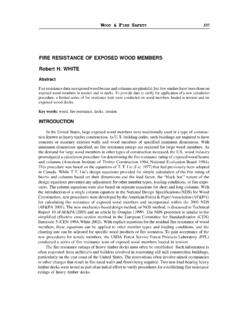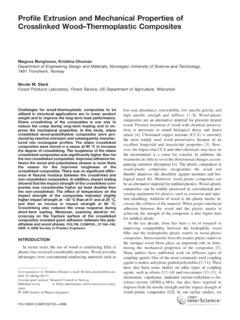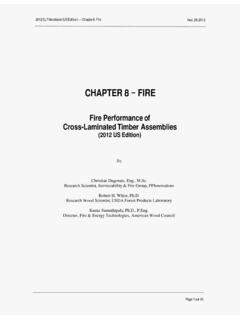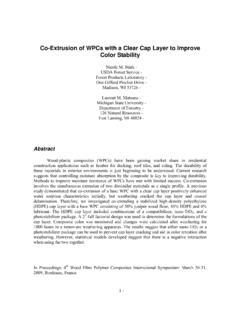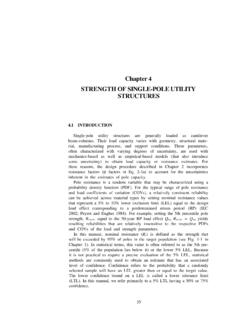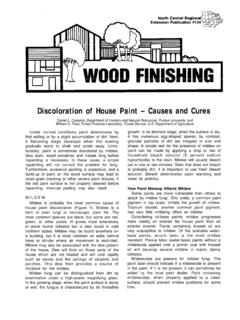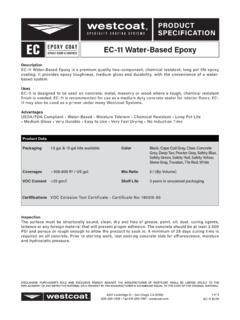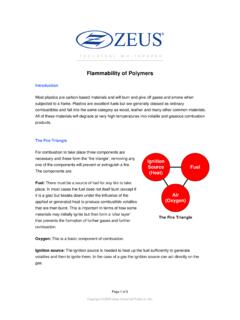Transcription of The Chemical Composition of Wood - Forest Products …
1 The Chemical Composition of WoodROGER C. Department of Agriculture, Forest Service, Forest Products Laboratory,Madison, WI 53705 This chapter includes overall Chemical Composition ofwood, methods of analysis, structure of hemicellulosecomponents and degree of polymerization of carbohy-drates. Tables of data are compiled for woods of severalcountries. Components include: cellulose (Cross andBevan, holo-, and alpha-), lignin, pentosans, and in 1% sodium hydroxide, hot water, ethanol/benzene, and ether are reported. The data were col-lected at Forest Products Laboratory (Madison, Wis-consin) from 1927-68 and were previously data include both United States and foreignwoods. Previously published data include compositionsof woods from Borneo, Brazil, Cambodia, Chile, Co-lombia, Costa Rica, Ghana, Japan, Mexico, Mozam-bique, Papua New Guinea, the Philippines, Puerto Rico,Taiwan, and the USSR.
2 Data from more detailed anal-yses are presented for common temperate-zone woodsand include the individual sugar Composition (as glucan,xylan, galactan, arabinan, and mannan), uronic anhy-dride, acetyl, lignin, and Chemical Composition of wood cannot be defined pre-cisely for a given tree species or even for a given tree. Chemicalcomposition varies with tree part (root, stem, or branch), type ofwood (i. e., normal, tension, or compression) geographic location, cli-mate, and soil conditions. Analytical data accumulated from manyyears of work and from many different laboratories have helped todefine average expected values for the Chemical Composition of Chemical analysis can distinguish between hardwoods (an-giosperms) and softwoods (gymnosperrns). Unfortunately, such tech-niques cannot be used to identify individual tree species because ofthe variation within each species and the similarities among manyspecies.
3 Further identification is possible with detailed Chemical anal-This chapter not subject to 1984, American Chemical Society58 THE CHEMISTRY OF SOLID WOOD ysis of extractives (chemotaxonomy). Chemotaxonomy is discussedfully elsewhere in the literature (1, 2).There are two major Chemical components in wood: lignin (18 35%) and carbohydrate (65 75%). Both are complex, polymeric ma-terials. Minor amounts of extraneous materials, mostly in the formof organic extractives and inorganic minerals (ash), are also presentin wood (usually 4 10%). Overall, wood has an elemental composi-tion of about 50% carbon, 6% hydrogen, 44% oxygen, and traceamounts of several metal complete Chemical analysis accounts for all the components ofthe original wood sample.
4 Thus, if wood is defined as part lignin,part carbohydrate, and part extraneous material, analyses for each ofthese components should sum to 100%. The procedure becomesmore complex as the component parts are defined with greater data are frequently adjusted to 100% by introducing cor-rection factors in the analytical calculations. Wise and coworkers (3)presented an interesting study on the summative analysis of woodand analyses of the carbohydrate fractions. The complete analyticalreport also includes details of the sample, such as species, age, andlocation of the tree, how the sample was obtained from the tree, andhorn what part of the tree. The type of wood analyzed is also impor-tant; , compression, tension, or normal amounts of data are available on the Chemical compositionof wood. Fengel and Grosser (4) made a compilation for temperate-zone woods .
5 This chapter is a compilation of data for many differentspecies from all parts of the world, and includes much of the data inReference 4. The tables at the end of this chapter summarize ComponentsCarbohydrates. The carbohydrate portion of wood comprisescellulose and the hemicelluloses. Cellulose content ranges from 40to 50% of the dry wood weight, and hemicelluloses range from 25 to35%.CELLULOSE. Cellulose is a glucan polymer consisting of linearchains of 1,4- -bonded anhydroglucose units. (The notation 1,4- describes the bond linkage and the configuration of the oxygen atombetween adjacent glucose units.) Figure 1 shows a structural diagramof a portion of a glucan chain. The number of sugar units in onemolecular chain is referred to as the degree of polymerization (DP).Even the most uniform sample has molecular chains with slightlydifferent DP values.
6 The average DP for the molecular chains in agiven sample is designated by ~.2. PETTERSENThe Chemical Composition of Wood5960 THE CHEMISTRY OF SOLID WOODG oring and Timell (5) determined the ~ for native cellulosefrom several sources of plant material. They used a nitration isolationprocedure that attempts to maximize the yield while minimizing thedepolymerization of the cellulose. These molecular weight determi-nations, done by light-scattering experiments, indicate wood cellu-lose has a ~ of at least 9,000-10,000, and possibly as high as 15, DP of 10,000 would mean a linear chain length of approximately5 m in ~ obtained from light-scattering experiments is biased up-ward because light scattering increases exponentially with molecularsize. The value obtained is usually referred to as the weighted ~or ~.. The number average degree of polymerization ~.
7 Is usu-ally obtained from osmometry measurements. These measurementsare linear with respect to molecular size and, therefore, a moleculeis counted equally as one molecule regardless of its size. The ratioof ~W to ~n is a measure of the molecular weight ratio is nearly one for native cellulose in secondary cell walls ofplants (6). Therefore, this cellulose is monodisperse and contains mol-ecules of only one size. Cellulose in the primary wall has a lower IJFand is thought to be polydisperse. (See Reference 7 for a discussionof molecular weight distribution in synthetic polymers. )Native cellulose is partially crystalline. X-Ray diffraction exper-iments indicate crystalline cellulose (Valonia uentricosa) has spacegroup symmetry P21 with a = , b = , c = , and = (8). The unit cell contains eight cellobiose moieties. Themolecular chains pack in layers that are held together by weak vander Waals forces (Figure 2a).
8 The layers consist of parallel chains ofanhydroglucose units, and the chains are held together by intermo-lecular hydrogen bonds. There are also intramolecular hydrogenbonds between the atoms of adjacent glucose residues (Figure 2b).This structure is called cellulose are at least three other structures reported for modifiedcrystalline cellulose. The most important is cellulose II, obtained bymercerization or regeneration of native cellulose. Mercerization istreatment of cellulose with strong alkali. Regeneration is treatmentof cellulose with strong alkali and carbon disulfide to form a solublexanthate derivative. The derivative is converted back to cellulose andreprecipitated as regenerated cellulose. The structure of cellulose II(regenerated) has space group symmetry P21 with a = , b = , c = , and = , and two cellobiose moieties perunit cell (9).
9 The packing arrangement is modified in cellulose II,and permits a more intricate hydrogen-bonded network that extendsbetween layers as well as within layers (Figure 3). The result is a2. PETTERSENThe Chemical Composition of Wood6162 THE CHEMISTRY OF SOLID WOOD more thermodynamically stable substance. Evidently, all native cel-lulose have the structure of cellulose is insoluble in most solvents including strong alkali. Itis difficult to isolate from wood in pure form because it is intimatelyassociated with the lignin and hemicelluloses. Analytical methods ofcellulose preparation are discussed in the section on Analytical Pro-cedures. HEMCELLULOSES. Hemicelluloses are mixtures of polysaccha-rides synthesized in wood almost entirely from glucose, mannose,galactose, xylose, arabinose, 4-O methylglucuronic acid, and galac-turonic acid residues.
10 Some hardwoods contain trace amounts ofrhamnose. Generally, hemicelluloses are of much lower molecularweight than cellulose and some are branched. They are intimatelyassociated with cellulose and appear to contribute as a structuralcomponent in the plant. Some hemicelluloses are present in abnor-mally large amounts when the plant is under stress; , compressionwood has a higher than normal galactose content as well as a higherlignin content (11). Hemicelluloses are soluble in alkali and easilyhydrolyzed by structure of hemicelluloses can be understood by first con-sidering the conformation of the monomer units (Figure 4). Thereare three entries under each monomer in Figure 4. In each entry,the letter designations D and L refer to a standard configuration forthe two optical isomers of glyceraldehyde, the simplest Greek letters and refer to the configuration of the hydroxylgroup at carbon atom 1.

